Electric Vehicles and Vehicle–Grid Interaction in the Turkish Electricity System
Abstract
1. Introduction
2. Problems with Charging Electric Vehicles in Turkey Advantages and Disadvantages of V2G
V2G Advantages and Disadvantages
3. Materials and Methods
3.1. Conceptual Assumptions
3.2. Optimal V2G Planning
3.3. V2G Optimization Limitations
3.4. Tool Description and Sampling Method
3.5. Charging Profiles
3.6. Findings on V2G Optimization
4. Discussion
4.1. Bidirectional V2G
4.2. Round-Trip Misuse
4.3. Battery Status of Charging Problem
4.4. Two-Way Results
4.5. Modeling of the EV Load
5. Conclusions
Author Contributions
Funding
Institutional Review Board Statement
Informed Consent Statement
Data Availability Statement
Conflicts of Interest
Abbreviations
| HEV | Hybrid electric vehicles. |
| PHEV | Plug-in hybrid electric vehicle. |
| BEV | Battery electric vehicle. |
| FCEV | Fuel cell electric vehicles. |
| ICE | Internal combustion engine. |
| Maximum power consumption EV. | |
| Minimum power consumption EV. | |
| Power consumption reduction EV. | |
| Best performance point. | |
| Unexpected departures compensation coefficient. | |
| Initial state of charge. | |
| State of charge. | |
| Maximum battery charging capacity. | |
| EV | availability. |
| Total power consumption. | |
| Efficiency of the battery charger. | |
| Profit. | |
| Percentage of revenues earned by the aggregator. | |
| time index. | |
| electric vehicle index. | |
| electric energy of the regulation reduced for the time t. | |
| electric energy regulation until time t. | |
| electricity reserved for the period t. | |
| Expected percentage of electric vehicles not performing V2G. | |
| Electricity price for V2G aggregator customer. | |
| Final power consumption EV. | |
| Probability of unexpected EV departure. | |
| Electricity price, which can be a fixed, market or coalition price. |
References
- Martins, F.; Felgueiras, C.; Smitkova, M.; Caetano, N. Analysis of Fossil Fuel Energy Consumption and Environmental Impacts in European Countries. Energies 2019, 12, 964. [Google Scholar] [CrossRef]
- Schlesinger, J.; Robert, L.H. Getting Real on Wind and Solar. In Washington Post; 2009; Available online: https://www.almendron.com/tribuna/getting-real-on-wind-and-solar/ (accessed on 1 January 2020).
- Friesen, K.M. When the sun don’t shine and the wind don’t blow: Solving the intermittency problem and moving to a zero carbon future. Pacific J. 2021, 16, 11–25. [Google Scholar]
- Mwasilu, F.; Justo, J.J.; Kim, E.-K.; Do, T.D.; Jung, J.-W. Electric vehicles and smart grid interaction: A review on vehicle to grid and renewable energy sources integration. Renew. Sustain. Energy Rev. 2014, 34, 501–516. [Google Scholar] [CrossRef]
- Najjar, Y.S.H. Gaseous Pollutants Formation and Their Harmful Effects on Health and Environment. Innov. Energy Policies 2011, 1, 1–9. [Google Scholar] [CrossRef]
- Jegannathan, K.R.; Chan, E.-S.; Ravindra, P. Biotechnology in Biofuels-A Cleaner Technology. J. Appl. Sci. 2011, 11, 2421–2425. [Google Scholar] [CrossRef]
- Solaymani, S. CO2 emissions patterns in 7 top carbon emitter economies: The case of transport sector. Energy 2019, 168, 989–1001. [Google Scholar] [CrossRef]
- Santos, G. Road transport and CO2 emissions: What are the challenges? Transp. Policy 2017, 59, 71–74. [Google Scholar] [CrossRef]
- Saiteja, P.; Ashok, B. Critical review on structural architecture, energy control strategies and development process towards optimal energy management in hybrid vehicles. Renew. Sustain. Energy Rev. 2022, 157, 112038. [Google Scholar] [CrossRef]
- Fernández, R.; Pérez-Dávila, O. Fuel cell hybrid vehicles and their role in the decarbonisation of road transport. J. Clean. Prod. 2022, 342, 130902. [Google Scholar] [CrossRef]
- Kandidayeni, M.; Trovão, J.; Soleymani, M.; Boulon, L. Towards health-aware energy management strategies in fuel cell hybrid electric vehicles: A review. Int. J. Hydrog. Energy 2022, 47, 10021–10043. [Google Scholar] [CrossRef]
- Venugopal, P.; Haes Alhelou, H.; Al-Hinai, A.; Siano, P. Analysis of Electric Vehicles with an Economic Perspective for the Future Electric Market. Futur. Internet 2022, 14, 172. [Google Scholar] [CrossRef]
- Mangipinto, A.; Lombardi, F.; Sanvito, F.D.; Pavičević, M.; Quoilin, S.; Colombo, E. Impact of mass-scale deployment of electric vehicles and benefits of smart charging across all European countries. Appl. Energy 2022, 312, 118676. [Google Scholar] [CrossRef]
- Burd, J.T.J.; Moore, E.A.; Ezzat, H.; Kirchain, R.; Roth, R. Improvements in electric vehicle battery technology influence vehicle lightweighting and material substitution decisions. Appl. Energy 2021, 283, 116269. [Google Scholar] [CrossRef]
- Yang, C. Running battery electric vehicles with extended range: Coupling cost and energy analysis. Appl. Energy 2022, 306, 118116. [Google Scholar] [CrossRef]
- Sanguesa, J.; Torres-Sanz, V.; Garrido, P.; Martinez, F.; Marquez-Barja, J. A Review on Electric Vehicles: Technologies and Challenges. Smart Cities 2021, 4, 372–404. [Google Scholar] [CrossRef]
- Wang, N.; Tang, L.; Pan, H. A global comparison and assessment of incentive policy on electric vehicle promotion. Sustain. Cities Soc. 2019, 44, 597–603. [Google Scholar] [CrossRef]
- Rietmann, N.; Lieven, T. A Comparison of Policy Measures Promoting Electric Vehicles in 20 Countries; Springer: Cham, Switzerland, 2019; pp. 125–145. [Google Scholar] [CrossRef]
- Shafique, M.; Rafiq, M.; Azam, A.; Luo, X. Material flow analysis for end-of-life lithium-ion batteries from battery electric vehicles in the USA and China. Resour. Conserv. Recycl. 2022, 178, 106061. [Google Scholar] [CrossRef]
- Inala, K.P.; Sah, B.; Kumar, P.; Bose, S.K. Impact of V2G Communication on Grid Node Voltage at Charging Station in a Smart Grid Scenario. IEEE Syst. J. 2021, 15, 3749–3758. [Google Scholar] [CrossRef]
- Euronews. Türkiye’de Elektrikli Şarj Istasyonu Sayısı ne Kadar, Diğer Ülkelerde Durum ne? 2022. Available online: https://tr.euronews.com/2022/03/19/elektrikli-arac-say-s-art-yor-turkiye-ve-avrupa-da-sarj-istasyonlar-yeterli-mi#:~:text=Elektrikliaraçsayısı(2019)EAFO’yagöreTürkiye’de,sayısı3bin457idi (accessed on 1 January 2020).
- New Regulation in Turkey Revs up Support for EV Charging Stations, Daily Sabah. 2022. Available online: https://www.dailysabah.com/business/automotive/new-regulation-in-turkey-revs-up-support-for-ev-charging-stations (accessed on 1 January 2020).
- Das, S.; Acharjee, P.; Bhattacharya, A. Charging Scheduling of Electric Vehicle Incorporating Grid-to-Vehicle and Vehicle-to-Grid Technology Considering in Smart Grid. IEEE Trans. Ind. Appl. 2021, 57, 1688–1702. [Google Scholar] [CrossRef]
- Xu, N.Z.; Chung, C.Y.; Member, S. Reliability Evaluation of Distribution Systems Including Vehicle-to-Home and Vehicle-to-Grid. IEEE Trans. Power Syst. 2016, 31, 759–768. [Google Scholar] [CrossRef]
- Shirazi, Y.; Carr, E.; Knapp, L. A cost-benefit analysis of alternatively fueled buses with special considerations for V2G technology. Energy Policy 2015, 87, 591–603. [Google Scholar] [CrossRef]
- Chen, X.; Li, Z.; Dong, H.; Hu, Z.; Mi, C.C. Enabling Extreme Fast Charging Technology for Electric Vehicles. IEEE Trans. Intell. Transp. Syst. 2021, 22, 466–470. [Google Scholar] [CrossRef]
- Ağbulut, Ü.; Bakır, H. İçten Yanmalı Motorlar Yerine Elektrikli Araçlara Yönelmenin Ekonomik ve Ekolojik Etkilerinin Araştırılması. Düzce Üniversitesi Bilim Teknol. Derg. 2019, 7, 25–36. [Google Scholar] [CrossRef]
- Daramy-Williams, E.; Anable, J.; Grant-Muller, S. A systematic review of the evidence on plug-in electric vehicle user experience. Transp. Res. Part D Transp. Environ. 2019, 71, 22–36. [Google Scholar] [CrossRef]
- Togg. 2022. Available online: https://www.togg.com.tr/en/ (accessed on 1 January 2020).
- Türkiye’deki Elektrikli Otomobil Sayısı. 2022. Available online: https://www.enerjiatlasi.com/haber/turkiye-deki-elektrikli-otomobil-sayisi (accessed on 1 January 2020).
- Yılında Türkiye’de en Çok Satılan Elektrikli Otomobiller. 2022. Available online: https://www.ntv.com.tr/galeri/otomobil/2021-yilinda-turkiyede-en-cok-satilan-elektrikli-otomobiller,-5EKUAY75U20rEftkK5Dog (accessed on 1 January 2020).
- Muratori, M. Impact of uncoordinated plug-in electric vehicle charging on residential power demand. Nat. Energy 2018, 3, 193–201. [Google Scholar] [CrossRef]
- South Australia’s Big Battery. 2022. Available online: https://hornsdalepowerreserve.com.au/ (accessed on 1 January 2020).
- Mal, S.; Chattopadhyay, A.; Yang, A.; Gadh, R. Electric vehicle smart charging and vehicle-to-grid operation. Int. J. Parallel Emergent Distrib. Syst. 2013, 28, 249–265. [Google Scholar] [CrossRef]
- Will, C.; Schuller, A. Understanding user acceptance factors of electric vehicle smart charging. Transp. Res. Part C Emerg. Technol. 2016, 71, 198–214. [Google Scholar] [CrossRef]
- Kara, E.C.; Macdonald, J.S.; Black, D.; Bérges, M.; Hug, G.; Kiliccote, S. Estimating the benefits of electric vehicle smart charging at non-residential locations: A data-driven approach. Appl. Energy 2015, 155, 515–525. [Google Scholar] [CrossRef]
- Guo, J.; Yang, J.; Lin, Z.; Serrano, C.; Cortes, A.M. Impact Analysis of V2G Services on EV Battery Degradation—A Review. In Proceedings of the 2019 IEEE Milan PowerTech, Milano, Italy, 23–27 June 2019; pp. 1–6. [Google Scholar] [CrossRef]
- Vadi, S.; Bayindir, R.; Colak, A.M.; Hossain, E. A Review on Communication Standards and Charging Topologies of V2G and V2H Operation Strategies. Energies 2019, 12, 3748. [Google Scholar] [CrossRef]
- Mouli, G.R.C.; Kaptein, J.; Bauer, P.; Zeman, M. Implementation of dynamic charging and V2G using Chademo and CCS/Combo DC charging standard. In Proceedings of the 2016 IEEE Transportation Electrification Conference and Expo (ITEC), Dearborn, MI, USA, 27–29 June 2016; pp. 1–6. [Google Scholar] [CrossRef]
- Ustun, T.S.; Ozansoy, C.R.; Zayegh, A. Implementing Vehicle-to-Grid (V2G) Technology with IEC 61850-7-420. IEEE Trans. Smart Grid 2013, 4, 1180–1187. [Google Scholar] [CrossRef]
- Quílez, M.G.; Abdel-Monem, M.; El Baghdadi, M.; Yang, Y.; Van Mierlo, J.; Hegazy, O. Modelling, Analysis and Performance Evaluation of Power Conversion Unit in G2V/V2G Application—A Review. Energies 2018, 11, 1082. [Google Scholar] [CrossRef]
- Khan, S.A.; Kadir, K.M.; Mahmood, K.S.; Alam, I.I.; Kamal, A.; Al Bashir, M. Technical investigation on V2G, S2V, and V2I for next generation smart city planning. J. Electron. Sci. Technol. 2019, 17, 100010. [Google Scholar] [CrossRef]
- Gao, J.; Xiao, Y.; Liu, J.; Liang, W.; Chen, C.P. A survey of communication/networking in Smart Grids. Futur. Gener. Comput. Syst. 2012, 28, 391–404. [Google Scholar] [CrossRef]
- Pelzer, D.; Ciechanowicz, D.; Aydt, H.; Knoll, A. A price-responsive dispatching strategy for Vehicle-to-Grid: An economic evaluation applied to the case of Singapore. J. Power Sources 2014, 256, 345–353. [Google Scholar] [CrossRef][Green Version]
- Battistelli, C.; Baringo, L.; Conejo, A. Optimal energy management of small electric energy systems including V2G facilities and renewable energy sources. Electr. Power Syst. Res. 2012, 92, 50–59. [Google Scholar] [CrossRef]
- The UWA Renewable Energy Vehicle Project. The University of Western Australia. 2022. Available online: https://therevproject.com/ (accessed on 1 January 2020).
- University of Oxford. V2GO (Vehicle-to-Grid Oxford). 2022. Available online: https://www.tsu.ox.ac.uk/research/v2go/ (accessed on 1 January 2020).
- Kester, J.; Noel, L.; de Rubens, G.Z.; Sovacool, B.K. Promoting Vehicle to Grid (V2G) in the Nordic region: Expert advice on policy mechanisms for accelerated diffusion. Energy Policy 2018, 116, 422–432. [Google Scholar] [CrossRef]
- Deb, S.; Al Ammar, E.A.; AlRajhi, H.; Alsaidan, I.; Shariff, S.M. V2G Pilot Projects; Review and Lessons Learnt. Dev. Charg. Infrastruct. Technol. Electr. Veh. 2022, 252–267. [Google Scholar] [CrossRef]
- Hive Power. Seven Global V2X Projects You Should Know. 2021. Available online: https://www.hivepower.tech/blog/seven-7-global-v2x-projects-you-should-know (accessed on 1 January 2020).
- Habib, S.; Kamran, M.; Rashid, U. Impact analysis of vehicle-to-grid technology and charging strategies of electric vehicles on distribution networks—A review. J. Power Sources 2015, 277, 205–214. [Google Scholar] [CrossRef]
- Lund, H.; Kempton, W. Integration of renewable energy into the transport and electricity sectors through V2G. Energy Policy 2008, 36, 3578–3587. [Google Scholar] [CrossRef]
- Transmission System Operator for Electricity in Turkey. Daily Statistics. 2022. Available online: https://ytbsbilgi.teias.gov.tr/ytbsbilgi/frm_istatistikler.jsf (accessed on 1 January 2020).
- Ghosh, D.P.; Thomas, R.J.; Wicker, S.B. A Privacy-Aware Design for the Vehicle-to-Grid Framework. In Proceedings of the 2013 46th Hawaii International Conference on System Sciences, Wailea, Hawaii, 7–10 January 2013; pp. 2283–2291. [Google Scholar] [CrossRef]
- Shi, W.; Wong, V.W. Real-time vehicle-to-grid control algorithm under price uncertainty. In Proceedings of the 2011 IEEE International Conference on Smart Grid Communications (SmartGridComm), Brussels, Belgium, 17–20 October 2011; pp. 261–266. [Google Scholar] [CrossRef]
- Naik, N.; Vyjayanthi, C. Optimization of Vehicle-to-Grid (V2G) Services for Development of Smart Electric Grid: A Review. In Proceedings of the 2021 International Conference on Smart Generation Computing, Communication and Networking (SMART GENCON), Pune, India, 29–30 October 2021; pp. 1–6. [Google Scholar] [CrossRef]
- Nakazawa, S. The Nissan LEAF electric powertrain. In 32. International Vienna Motor Symposium; Vienna, Austria, 2011; pp. 330–341. Available online: https://www.osti.gov/etdeweb/biblio/21478310 (accessed on 6 October 2022).
- Ansari, M.; Al-Awami, A.; Abido, M. Fuzzy Linear Programming Method for Optimizing Charging Schedules in Unidirectional Vehicle-to-Grid Systems. U.S. Patent 2016/0140449 A1, 19 May 2016. [Google Scholar]
- Varfolomejeva, R.; Sauhats, A.; Sokolovs, N.; Coban, H. The Influence of Small-Scale Power Plant Supporting Schemes on the Public Trader and Consumers. Energies 2017, 10, 800. [Google Scholar] [CrossRef]
- Padullaparti, H.V.; Chirapongsananurak, P.; Santoso, S.; Taylor, J.A. Edge-of-Grid Voltage Control: Device Modeling, Strategic Placement, and Application Considerations. IEEE Power Energy Technol. Syst. J. 2017, 4, 106–114. [Google Scholar] [CrossRef]
- Niesten, E.; Alkemade, F. How is value created and captured in smart grids? A review of the literature and an analysis of pilot projects. Renew. Sustain. Energy Rev. 2016, 53, 629–638. [Google Scholar] [CrossRef]
- Ourahou, M.; Ayrir, W.; EL Hassouni, B.; Haddi, A. Review on smart grid control and reliability in presence of renewable energies: Challenges and prospects. Math. Comput. Simul. 2018, 167, 19–31. [Google Scholar] [CrossRef]
- Coban, H.H.; Rehman, A.; Mousa, M. Load Frequency Control of Microgrid System by Battery and Pumped-Hydro Energy Storage. Water 2022, 14, 1818. [Google Scholar] [CrossRef]
- Sami, I.; Ullah, Z.; Salman, K.; Hussain, I.; Ali, S.M.; Khan, B.; Mehmood, C.A.; Farid, U. A Bidirectional Interactive Electric Vehicles Operation Modes: Vehicle-to-Grid (V2G) and Grid-to-Vehicle (G2V) Variations within Smart Grid. In Proceedings of the 2019 International Conference on Engineering and Emerging Technologies (ICEET), Lahore, Pakistan, 21–22 February 2019; pp. 1–6. [Google Scholar]
- Arfeen, Z.A.; Khairuddin, A.B.; Munir, A.; Azam, M.K.; Faisal, M.; Bin Arif, M.S. En route of electric vehicles with the vehicle to grid technique in distribution networks: Status and technological review. Energy Storage 2020, 2, e115. [Google Scholar] [CrossRef]
- Galus, M.D.; Vayá, M.G.; Krause, T.; Andersson, G. The role of electric vehicles in smart grids. In Advances in Energy Systems: The Large-Scale Renewable Energy Integration Challenge; John Wiley & Sons: Hoboken, NJ, USA, 2019; pp. 245–264. [Google Scholar]
- Xing, H.; Fu, M.; Lin, Z.; Mou, Y. Decentralized Optimal Scheduling for Charging and Discharging of Plug-In Electric Vehicles in Smart Grids. IEEE Trans. Power Syst. 2016, 31, 4118–4127. [Google Scholar] [CrossRef]
- Niekurzak, M.; Lewicki, W.; Drożdż, W.; Miązek, P. Measures for Assessing the Effectiveness of Investments for Electricity and Heat Generation from the Hybrid Cooperation of a Photovoltaic Installation with a Heat Pump on the Example of a Household. Energies 2022, 15, 6089. [Google Scholar] [CrossRef]
- Lewicki, W.; Drozdz, W. Electromobility and its Development Prospects in the Context of Industry 4.0: A Comparative Study of Poland and the European Union. Eur. Res. Stud. J. 2021, XXIV, 135–144. [Google Scholar] [CrossRef]



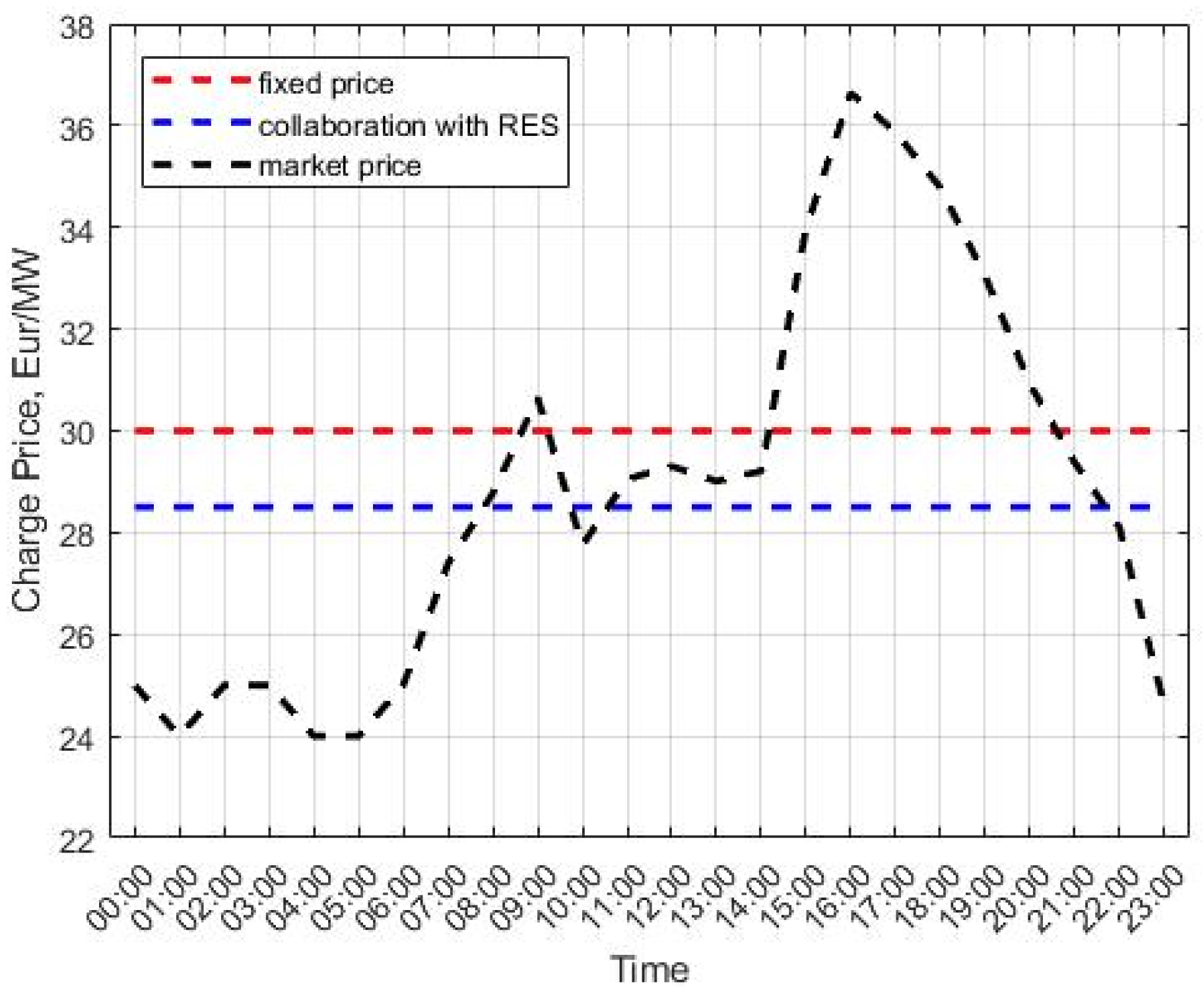
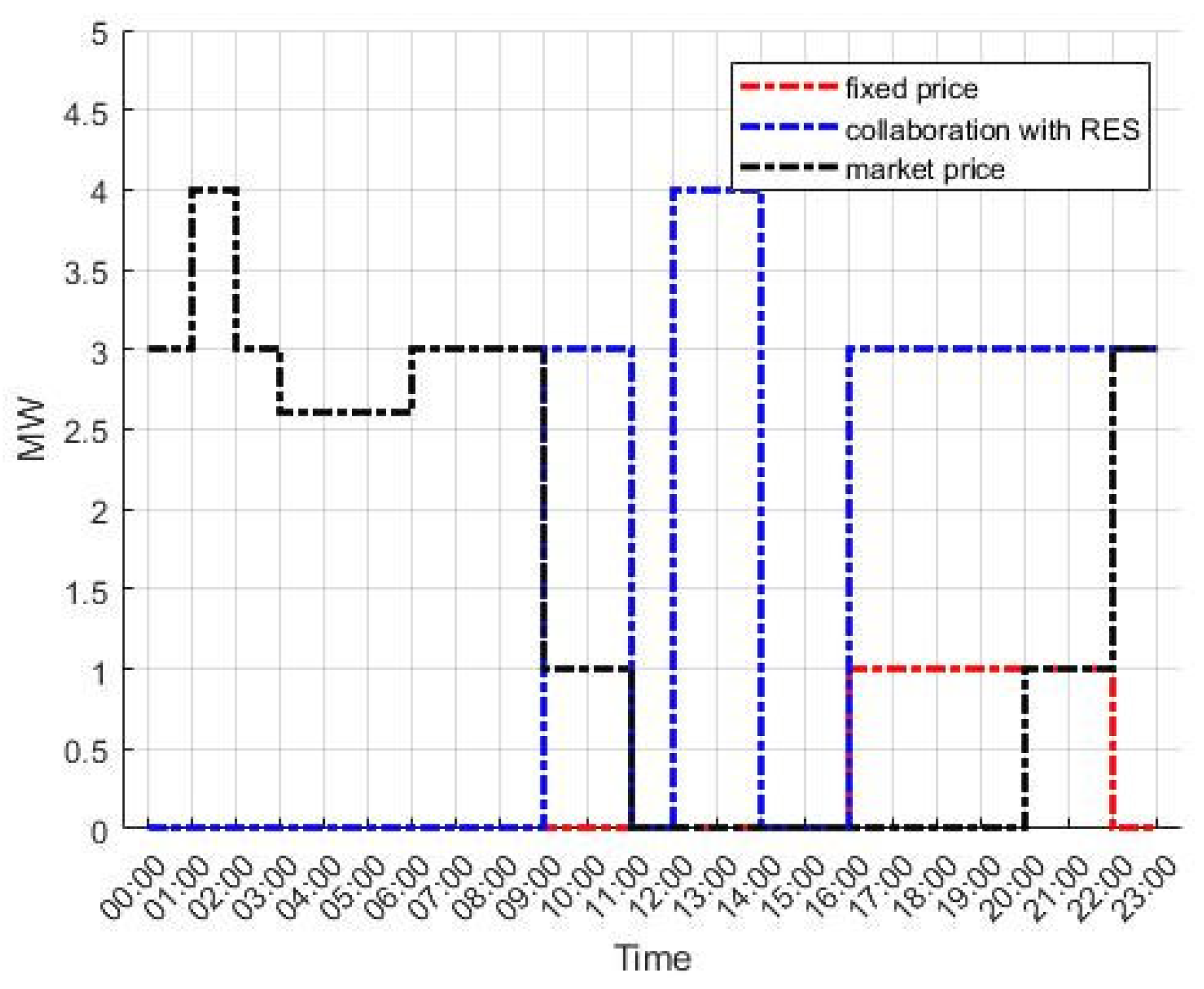

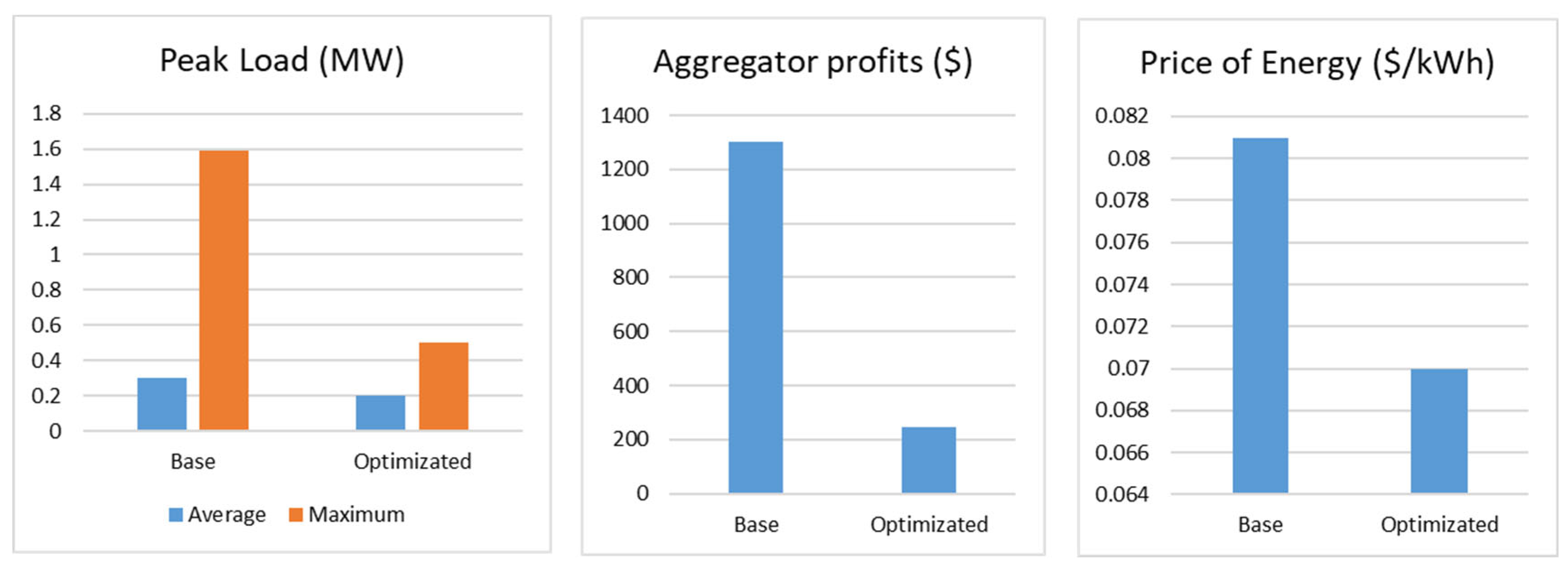

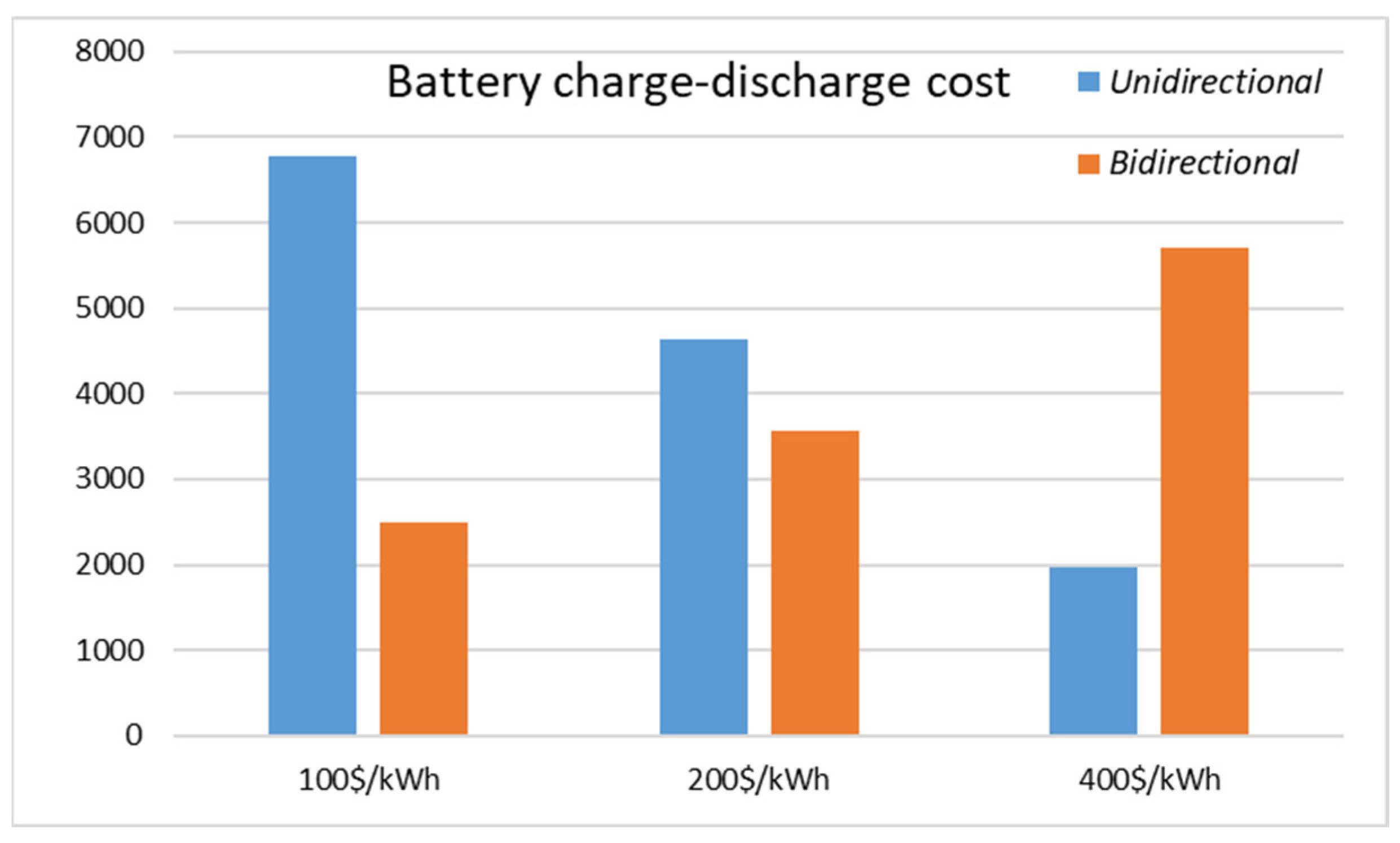
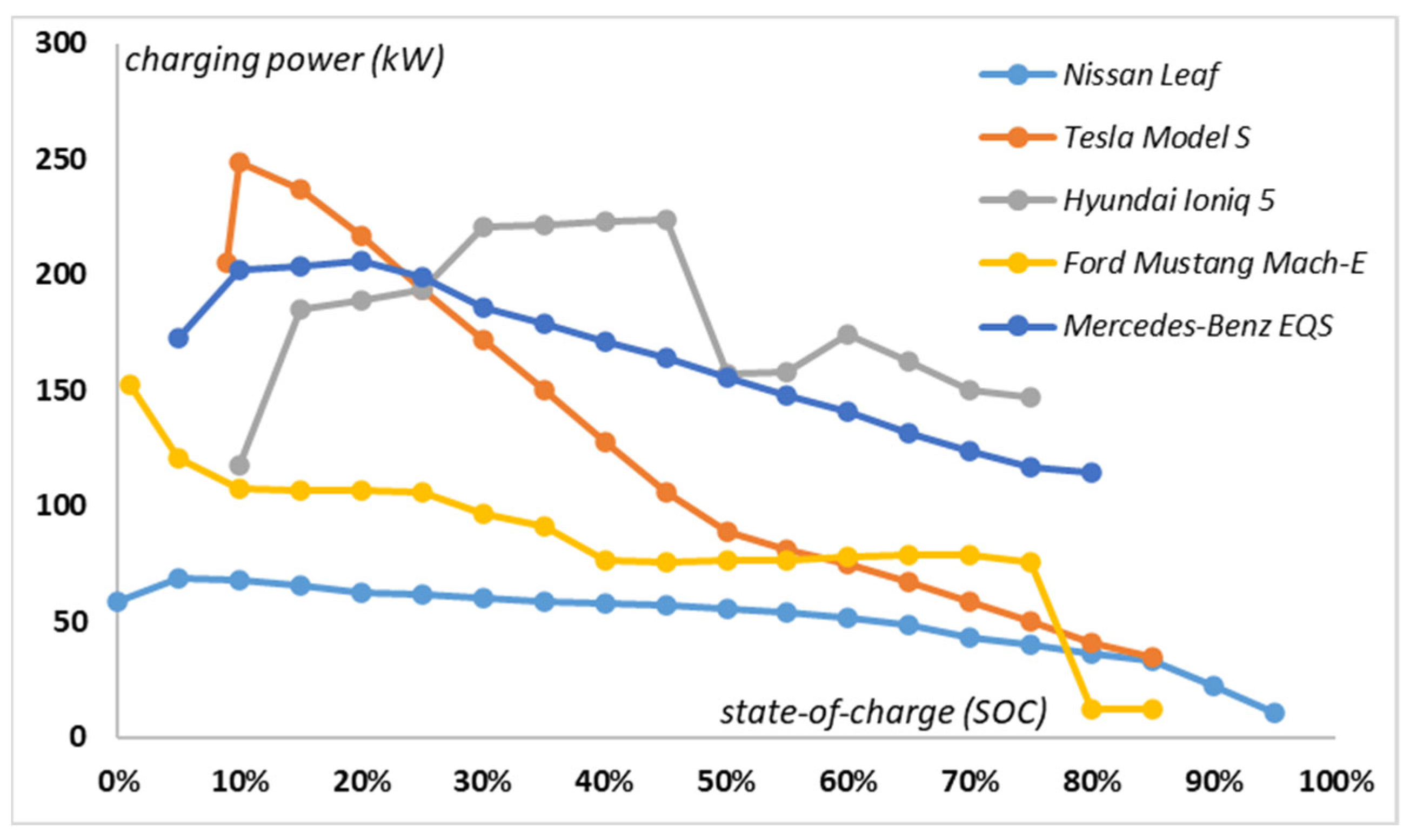
| Currently Restrictions | Benefits |
|---|---|
| No bidirectional chargers in vehicles. V2G needs bidirectional chargers which are more costly and bigger than unidirectional charges. | Storage of renewable energy |
| Battery degradation | Peak demand reduction |
| No ICT infrastructure | Emergency power supply |
| Lack of standardization and regulatory framework | Additional services |
| No incentives for the user | Grid operators can stabilize the grid and optimize investments |
| Average Hourly Charging Capacity | 3 MW |
|---|---|
| Average peak load increase | 1.5 MW |
| Maximum peak load Increase | 10.9 MW |
| Electricity price for the customer | USD 0.081/kWh |
| Aggregator Profits | USD 14,660 |
| Loose line | Base | 29.5 MWh |
| Optimized | 34.5 MWh (Revised losses 3.04%) | |
| Maximum line currents | Base | 32 A |
| Optimized | 40 A | |
| Service voltages in p.u. | Base | 0.954 |
| Optimized | 0.957 | |
| Number of overloads | Base | 0 |
| Optimized | 0 |
Publisher’s Note: MDPI stays neutral with regard to jurisdictional claims in published maps and institutional affiliations. |
© 2022 by the authors. Licensee MDPI, Basel, Switzerland. This article is an open access article distributed under the terms and conditions of the Creative Commons Attribution (CC BY) license (https://creativecommons.org/licenses/by/4.0/).
Share and Cite
Coban, H.H.; Lewicki, W.; Sendek-Matysiak, E.; Łosiewicz, Z.; Drożdż, W.; Miśkiewicz, R. Electric Vehicles and Vehicle–Grid Interaction in the Turkish Electricity System. Energies 2022, 15, 8218. https://doi.org/10.3390/en15218218
Coban HH, Lewicki W, Sendek-Matysiak E, Łosiewicz Z, Drożdż W, Miśkiewicz R. Electric Vehicles and Vehicle–Grid Interaction in the Turkish Electricity System. Energies. 2022; 15(21):8218. https://doi.org/10.3390/en15218218
Chicago/Turabian StyleCoban, Hasan Huseyin, Wojciech Lewicki, Ewelina Sendek-Matysiak, Zbigniew Łosiewicz, Wojciech Drożdż, and Radosław Miśkiewicz. 2022. "Electric Vehicles and Vehicle–Grid Interaction in the Turkish Electricity System" Energies 15, no. 21: 8218. https://doi.org/10.3390/en15218218
APA StyleCoban, H. H., Lewicki, W., Sendek-Matysiak, E., Łosiewicz, Z., Drożdż, W., & Miśkiewicz, R. (2022). Electric Vehicles and Vehicle–Grid Interaction in the Turkish Electricity System. Energies, 15(21), 8218. https://doi.org/10.3390/en15218218









